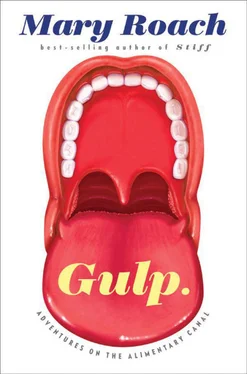This is no excuse for putting off your colonoscopy. Mannitol is no longer used, and doctors routinely blow air or nonflammable carbon dioxide into the colon as they work, which dilutes any pockets of hydrogen or methane. (Inflating the colon also helps them see what they’re doing. And creates the magnificent, billowing flatulence that rings through the colonoscopy recovery room.)
Outside the body, intestinal hydrogen and methane pose no danger. The act of passing flatus dilutes the gases, mixing them with the air in the room and lowering the concentration to levels well below combustibility. As anyone who has typed pyroflatulence into YouTube is aware, the match would have to contact the gas the second it’s blown from the body.
In the early days of the space program, NASA fretted about flammable astronaut flatus building up inside the tiny, hermetically sealed space capsules. A researcher presenting at the 1960s conference “Nutrition in Space and Related Waste Problems” was concerned enough to suggest that astronauts be selected from “that part of our population producing little or no methane or hydrogen.” NASA used to keep flatus expert Michael Levitt—whom you’ll meet shortly—on retainer as a consultant. Levitt assured them the capsules were large enough and the air inside sufficiently well circulated that intestinal contributions of hydrogen and methane were unlikely to reach a dangerous concentration. NASA was understandably wary. An earlier decision to circulate 100 percent oxygen in the capsules led to the deaths of all three Apollo 1 astronauts when a spark ignited a fierce fire during a launch-pad test.
EARLY ONE MORNING in the winter of 1890, a young British factory worker leaned from his bed to check the time. It was not yet dawn, the streets of Manchester still dark and shuttered. As he struck a match to see the hands of his timepiece, he happened to emit a belch. “To his consternation,” wrote Dr. James McNaught in the British Medical Journal , “the gas took fire, burned his face and lips considerably, and set fire to his moustache.”
Cases of “inflammable eructation”—McNaught cites eight other cases—are perplexing. The gas in a typical belch is either carbon dioxide (from carbonated drinks) or air swallowed while eating or drinking, both nonflammable. The healthy human stomach, unlike the colon, does not produce hydrogen or methane. Gastric acid’s job is to kill microorganisms; without them there can be no hydrogen- or methane-producing fermentation. Even if a relative few bacteria survive in a stomach—and some species can, we now know—the chymified food is passed on to the small intestine too quickly for fermentation to make much headway.
McNaught reached for his stomach tube. It had been five hours since the factory worker ate, a time lag normally sufficient for the stomach to finish its duties and pass the chyme along to the small intestine. Yet up came a pint and a half of a sour-smelling, soupy matter with a sediment of “grumous [82] Meaning “clotted or lumpy.” Grumous is one of many evocative words that deserve to break free from medical dictionaries and join the ranks of day-to-day vocabulary. Likewise, glabrous (“smooth and hairless”), periblepsis (“the wild look of delirium”), and maculate (“spotted”).
remains of food.” And gas, lots of it, visible as a head of frothy bubbles, foaming and bursting like the contents of a mad scientist’s beaker.
To identify the gas and confirm its flammability, McNaught had only to collect some from the headspace of the beaker and set it alight. But that’s no fun. Instead, on a different day, McNaught had the man yet again visit his office. Through a tube, he poured water into the misbehaving stomach, to displace the gas. As he did so, he held a flame to the invisible plume issuing from the man’s mouth. “The result… was to produce a flame of dimensions alarming to both the patient and myself.” Maybe I’m projecting, but a poorly suppressed schoolboy glee occasionally surfaces in McNaught’s writing, setting it off from the typical Hippocratic benevolence of British Medical Journal prose. If I had a medical license, I fear I’d be a Dr. McNaught.
It turned out that owing to strictures of the pylorus, the stomach’s lower sphincter, [83] Pylorus is Greek for “gatekeeper.” That’s all. As you were.
the food in the young man’s stomach was held back an uncommonly long time. Plus, McNaught claimed to have cultivated strains of acid-resistant, gas-producing bacteria. Carbohydrates plus bacteria plus time and body heat equals fermentation.
The story made me curious about cows. As we learned earlier, the rumen is a vast fermentation pit, a massive bacterial slum. A grazing cow can produce a hundred gallons of methane a day, vented, as stomach gases typically are, through the mouth. You would think that cow-belch-lighting would rival cow-tipping as a late-night diversion for bored rural youth. How is it that growing up in New Hampshire I never heard a cow belch? My ag pal Ed DePeters had the answer. When a ruminant is feeling bloated and needs to make room in her rumen, she pushes out some methane, but instead of belching it up, she can shift her internal tubing to reroute the gas down into the lungs and then quietly exhale it. To, say, a pronghorn out on the savannah, quiet can be key to survival. “Ungulates in the wild tend to go off and hide someplace while they ruminate,” DePeters explained. “If a lion walks by and hears a loud urrp …” Sayonara , antelope.
Because my readers, perhaps more than anyone else’s, might be inspired to head out to the pasture with a lighter in their pocket and bovine malfeasance in their heart, let me add this: lighting a cow’s breath will not produce a McNaughtian geyser of flame. Because of the afore-described methane rerouting system, the gas is diluted by nonflammable gases in the breath. For ignition, you would need the sort of concentrated blast that is a belch. And cows don’t belch.
Snakes don’t either, but they can, under certain circumstances, create an inflammable eructation of literally mythical proportions. For this story, we leave Ed DePeters in his muck boots and feed cap and turn to our snake digestion man in Alabama, Stephen Secor. First, a little background: Many plant-eating animals lack rumens, so some fermenting takes place in the cecum, an anatomical pouch at the junction of the small intestine and the colon. These same plant-eaters—horses, rabbits, koalas, to name three—tend to have a larger-than-average cecum. Pythons and boas do too, which struck Secor as odd, because they’re carnivores. Why, he wondered, would a meat-eater need a vegetation digestion unit? Secor theorized that perhaps these snakes had evolved ceca as a way to digest and take advantage of plant matter inside the stomachs of their prey.
To test his theory, Secor fed rats [84] Purchased in bulk from RodentPro.com. Life is cheap at RodentPro, as cheap as sixteen cents for an extra small pinky (a one-day-old frozen feeder mouse). Mice are also available in fuzzy (ten to fifteen days old), white peach fuzzy (“Just the right size when a pinky is too small and a fuzzy is too large”), hopper, weanling, and adult. Feeder rats and guinea pigs are sized like T-shirts: XS, S, M, L, XL, and XXL. RodentPro gift certificates are available. Because nothing says “I love you” like $100 of dead rodents delivered to the doorstep.
to some of the pythons in his lab at the University of Alabama and hooked them up to a gas chromatograph. He tracked the hydrogen level in their exhalations as they digested whole rats over the course of four days. He did see a spike, but it appeared long before the rat arrived at the python’s cecum. Instead, Secor suspected, the hydrogen spikes were the result of the decomposing, gas-bloated rat bursting inside the python. “One thing led to another.” (Secor’s way of saying he popped a bloated rat corpse and measured the hydrogen that came off it.) Suspicion confirmed. The hydrogen level was “through the roof.” Secor had stumbled onto a biological explanation for the myth of the fire-breathing dragon. Stay with me. This is very cool.
Читать дальше












